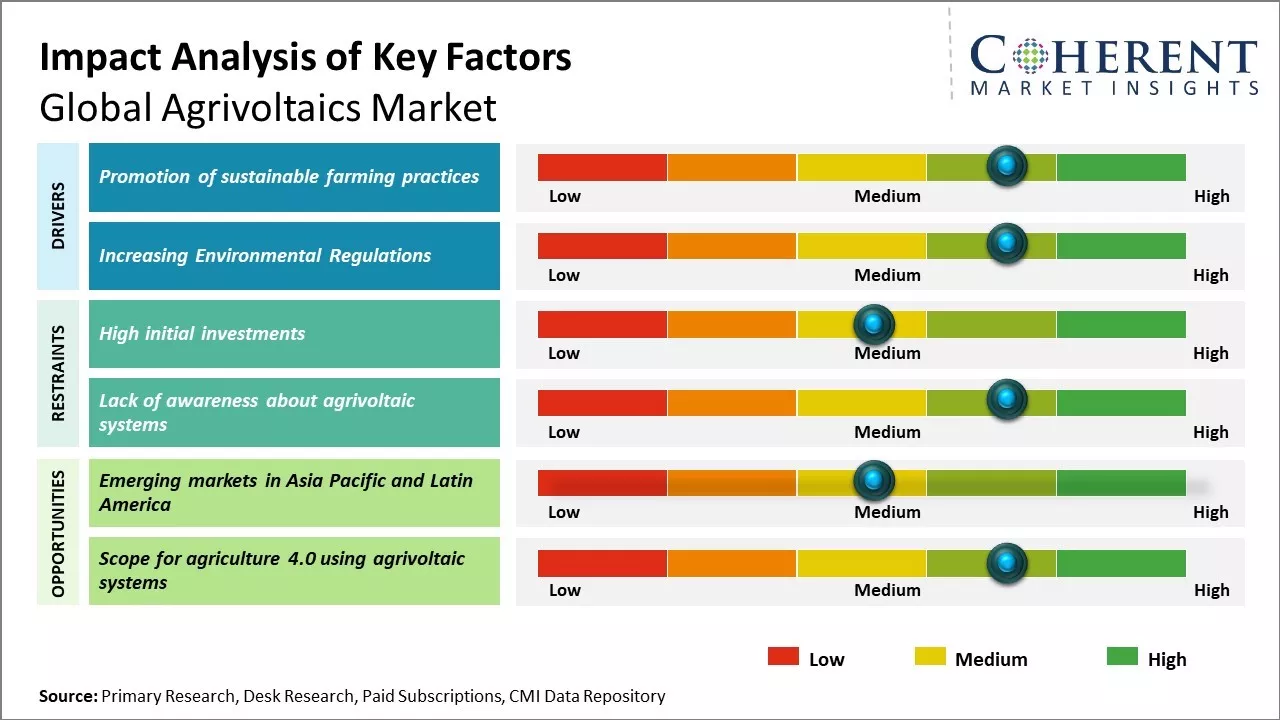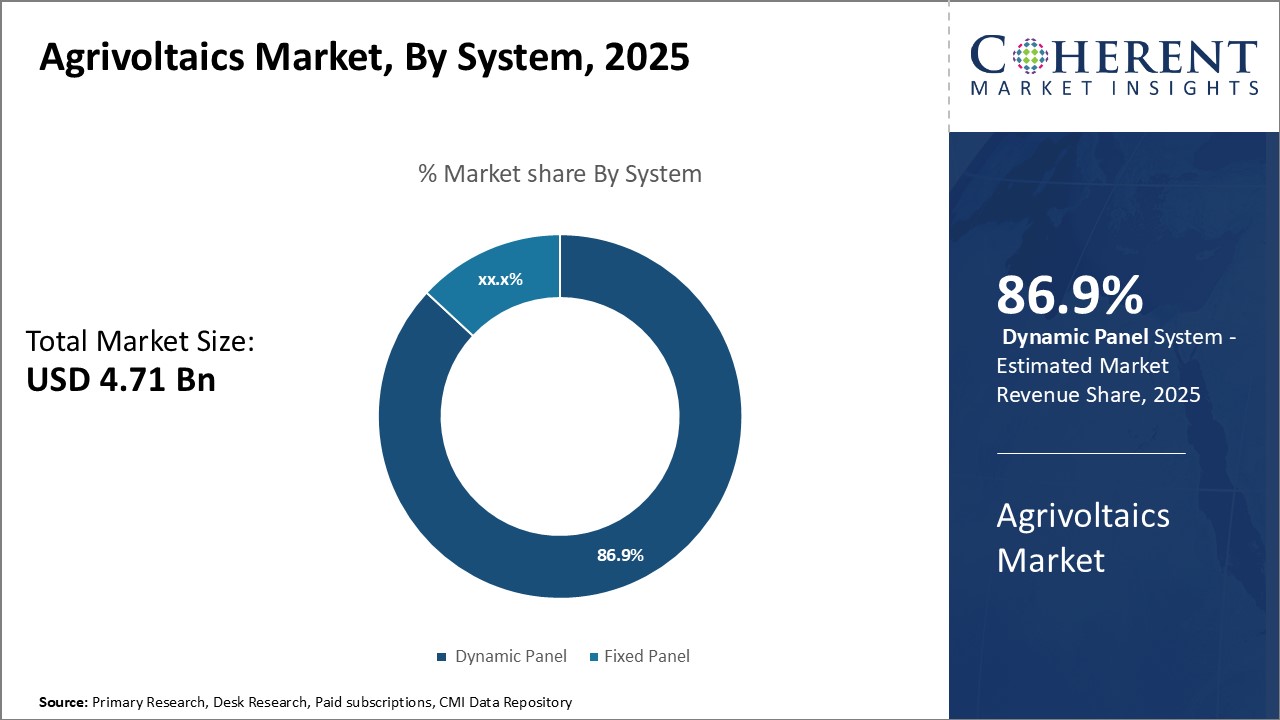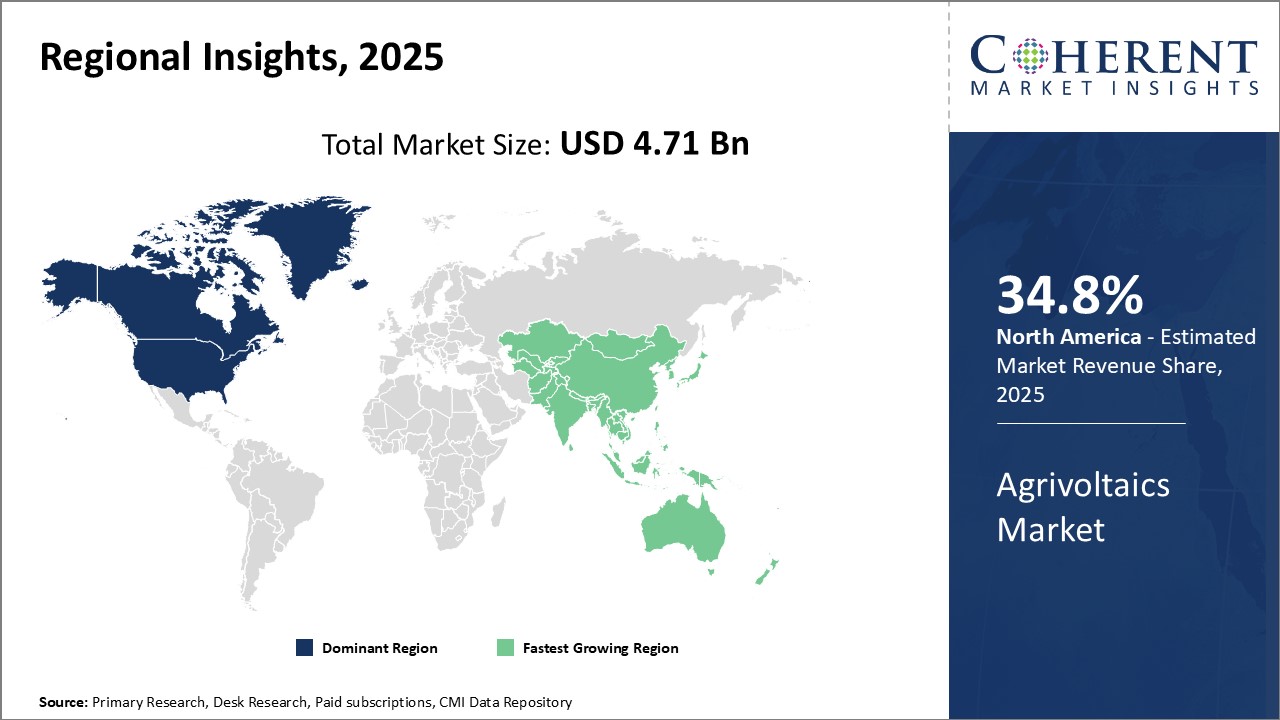The Agrivoltaics Market is estimated to be valued at USD 4.71 Bn in 2025 and is expected to reach USD 8.34 Bn by 2032, exhibiting a compound annual growth rate (CAGR) of 8.5% from 2025 to 2032.

Discover market dynamics shaping the industry: Request sample copy
The growing need for dual use of land for energy production and agriculture is expected to drive the demand for agrivoltaics. Further, agrivoltaic systems help increase yield for certain crops by providing partial shade and protecting crops from excessive heat. They also improve water use efficiency as solar panels provide shade and influence the microclimate beneath them. Additionally, growing emphasis on sustainability and development of agro-based economies are anticipated to provide opportunities for the market. However, high initial investment and limited technical know-how may hamper the growth of the agrivoltaics market during the forecast period.
Promotion of sustainable farming practices
Rising global temperatures and changing weather patterns have made conventional farming more challenging in many parts of the world. Farmers are struggling with increased occurrences of droughts, floods, and other climate-related disruptions which damage crops and reduce farm yields. At the same time, the agricultural sector remains a significant contributor to greenhouse gas emissions that cause global warming. There is a growing need to adopt renewable energy-powered farming techniques that are less dependent on climate variations and are more environmentally sustainable.
Agrivoltaic systems which involve setting up solar panels above crop fields have emerged as a promising solution. The partial shading from solar panels creates the ideal microclimate for many crops to grow by reducing evapotranspiration and moderating temperature fluctuations. It allows more efficient use of available land resource for combined power and food production. Farmers can supplement their income from solar power sales while continuing farming under the panels. The dual use of land helps optimize land utilization and preserves agricultural areas that otherwise would be converted to large-scale solar installations. Many governments around the world are promoting agrivoltaics to make agriculture greener. Farmers are incentivized to install agrivoltaic systems through financial subsidies and policy support in order to optimize resource use as well as generate renewable energy. As more studies demonstrate the agronomic and climate adaptation benefits of this practice, agrivoltaics is likely to grow in popularity among farmers.

Get actionable strategies to beat competition: Request sample copy
Maximizing Self-consumption of Solar Power
A key driver for the adoption of agrivoltaic systems by farmers and landowners is its ability to maximize self-consumption of on-site solar power generation. Farms and agricultural landholding areas are often located in remote regions with poor access to central electricity grids. Transporting power over long distances results in transmission and distribution losses, making grid electricity costly for rural consumers. Agrivoltaic systems help farmers and rural establishments meet a major part of their energy demand through direct self-consumption of solar energy, reducing dependence on expensive diesel generation or unreliable grid power. Any surplus power generated can be fed into the grid or used for local community needs or agricultural processing activities like cold storage, packaging, etc. This significantly enhances the economic feasibility of investments in solar projects for agricultural applications compared to regular ground-mounted installations or rooftop projects with low self-consumption.
Key Takeaways from Analyst:
The ability to generate solar power while maintaining agricultural productivity is a major driver for the increased adoption of agrivoltaic systems.
Farmers are able to generate additional revenue from leasing out their land for solar installations while still using the land for crops or livestock grazing. This dual-use of land provides an attractive value proposition compared to traditional land-based solar farms.
High initial installation costs remain a key restraint to widespread adoption. The use of more efficient bifacial solar modules and floating solar installations could help reduce costs. Storage integration is another area that needs more focus to optimize the energy production profile.
Market Challenges: High initial investments
The high initial investments required for setting up agrivoltaic projects is one of the major factors restraining the growth of the global agrivoltaics market. Agrivoltaic systems involve combining solar panels with agricultural crops which allows dual use of land for both energy production as well as cultivation. However, this integrated approach makes the installation and construction of agrivoltaic farms quite costly.
Setting up agrivoltaic systems involve high costs related to land procurement, installation of robust solar panel structures, tracking equipment, wiring, inverters, battery storage solutions and other ancillary equipment. Moreover, specialised smart technologies and sophisticated designs are required to ensure optimal sunlight and shadow distribution between crops and solar panels throughout the day. This makes the overall project cost per unit of installed capacity for agrivoltaic farms higher than conventional ground-mounted solar parks. Additional costs are also involved for feasibility studies, certification, policy support and farmer training.
Market Opportunities: Emerging markets in Asia Pacific and Latin America
The agrivoltaic market has strong growth prospects in emerging economies across Asia Pacific and Latin America. These regions have ideal geographic and climate conditions to implement agrivoltaic solutions at scale. Countries like India, China, Brazil and Mexico have enormous potential for agricultural production but face challenges of lack of electricity access in rural areas and effects of climate change like erratic rainfall patterns. Agrivoltaic systems offer a sustainable solution by generating solar power while providing partial shading for crops below the panels. This helps increase yield by protecting crops from excessive heat and moisture loss, ensuring year-round harvest. The dual benefit of energy generation and enhanced crop productivity makes agrivoltaics highly appealing for these markets.
According to United Nations World Food Programme, an estimated 18 million hectares of agricultural land in India lies abandoned each year due to lack of adequate irrigation facilities. Agrivoltaic projects integrated with micro-irrigation solutions have the potential to revitalize millions of hectares of abandoned farmland, empower smallholder farmers and boost rural incomes levels. Successful pilot projects in India and China have demonstrated agrivoltaics enhancing crop yields by 15-25% compared to conventional farming techniques.

Discover high revenue pocket segments and roadmap to it: Request sample copy
Insights by system: Dynamic Panels Drive Growth in the Agrivoltaics Systems Segment
Dynamic panel systems are contributing significantly to growth in the Agrivoltaics market owing to their unique ability to optimize solar energy generation and crop yields with 86.9% share in 2025. Traditional fixed panel structures provide consistent shade but also cast shadows that can inhibit photosynthesis in some plant varieties. Dynamic panels overcome this challenge through adjustable designs that track the sun's movement throughout the day and position the solar arrays to maximize sunlight exposure for crops below.
This tracking functionality allows for more efficient energy harvesting from the sun while also permitting flexible light and shade conditions tailored to specific crop needs. Many vegetable, fruit, and root crops have been shown to thrive under the intermittent sunlight pattern created by dynamic panels as they tilt and rotate above the agricultural area. Researchers continue working to refine control algorithms that optimize both solar energy output and crop growth for different plant varieties through precision adjustments of panel positioning. As dynamic technology advances, upfront hardware costs are decreasing while power outputs and positioning accuracy improve. Additional studies demonstrate reduce water requirements for some crops grown beneath dynamic as opposed to fixed panels. This dual benefit of energy production and enhanced crop yields is driving expanded adoption of dynamic panel systems, especially for commercial operations seeking increased revenue potential per acre. Ongoing R&D also focuses on dynamic panel durability and integration with advanced soil sensors, irrigation systems, and data analytics to maximize the Agrivoltaics value proposition over the long term.
Insights by crop : Root Crops Lead Growth in the Agrivoltaics Crop Segment
Root crops such as potatoes, carrots, beets and radishes have emerged as a strong contributor to the expanding Agrivoltaics market based on crop type with 42.7% share in 2025. These subterranean edible plant varieties are well-suited to cultivating beneath solar panel structures, which provide optimized sunlight levels through flexible shading conditions.
Root crops require less direct sunlight exposure compared to many leafy vegetable or fruit varieties and have shown good yields when grown under partial or intermittent shade. Their subterranean habitat also means roots are less susceptible to overheating risks that can impact some above-ground crops under full solar exposure. Additionally, the physical positioning of root crop harvests beneath the soil makes them less visually impacted by overhead solar panel shadows versus aerial plant parts. As Agrivoltaics research intensifies, root vegetable cultivation is under study as a promising application with dual benefits. In addition to solar energy generation, preliminary studies indicate potential water savings along with weed suppression from groundcover effects compared to traditional root crop growing methods. Going forward, focus remains on identifying optimal panel height, shading patterns and groundcover management techniques for maximizing yields of high-demand root vegetables. Their compatibility combined with consumer demand is cementing root crops as a leading application segment driving Agrivoltaics industry development.

Need a Different Region or Segment? Customize now
North America has dominated the agrivoltaics market for many years owing to strong government support through incentives and policies promoting renewable energy adoption and is estimated to account for 34.8% share in 2025. The U.S. is the largest market in the region supported by the presence of major players along with developing solar supply chains and infrastructure. States such as California, Massachusetts, and New York have pioneered agrivoltaic projects through regulatory frameworks facilitating investment in this area. Leading agrivoltaic installation companies partner with large farms to deploy solutions tailored for their crops and operations. The incentive programs significantly lowering installation and procurement costs have encouraged commercialization. Moreover, land availability is abundant and farmers are open to newer techniques enhancing their revenue streams without disrupting agricultural production.
The Asia Pacific region has emerged as the fastest growing market for agrivoltaics globally. Incentives and targets to strengthen farm-based renewable capacity have accelerated business opportunities. Countries like China, Japan, South Korea and India are at the forefront due to expanding agricultural output and rising demand for renewable power. Farmers in densely populated countries seek methods to utilize limited arable land more productively. The government of China has announced large investments to promote agrivoltaics as part of its agri-technology innovation drive. This helps domestic manufacturers rapidly scale up production to serve lucrative domestic and overseas markets. India too is investing in rural electrification programs merging solar energy generation with agriculture across its vast terrain. Projects in northern states have showcased the feasibility of cultivating crops below solar panels, high uptake is expected going forward.
Agrivoltaics Market Report Coverage
| Report Coverage | Details | ||
|---|---|---|---|
| Base Year: | 2024 | Market Size in 2025: | USD 4.71 Bn |
| Historical Data for: | 2020 To 2024 | Forecast Period: | 2025 To 2032 |
| Forecast Period 2025 to 2032 CAGR: | 8.5% | 2032 Value Projection: | USD 8.34 Bn |
| Geographies covered: |
|
||
| Segments covered: |
|
||
| Companies covered: |
Ombrea, SunAgri, SunSeed APV Private Limited, JA Solar Holdings Co. Ltd., Enel Green Power Spa, Mirai Solar, Namaste Solar, BayWa AG, Next2Sun Technology GmbH, and Insolight SA |
||
| Growth Drivers: |
|
||
| Restraints & Challenges: |
|
||
Uncover macros and micros vetted on 75+ parameters: Get instant access to report
*Definition: The Agrivoltaics Market involves incorporating solar panels into agricultural landscapes to maximize land productivity. It delivers renewable energy through photovoltaic panels mounted above crops or livestock to prevent shading. This dual-use approach for agricultural lands optimizes space by generating solar power while allowing crops to continue growing below. Agrivoltaics provides an innovative solution for agricultural producers to earn additional revenue from solar installations without losing valuable acreage for crop cultivation.
Share
Share
About Author
Yash Doshi is a Senior Management Consultant. He has 12+ years of experience in conducting research and handling consulting projects across verticals in APAC, EMEA, and the Americas.
He brings strong acumen in helping chemical companies navigate complex challenges and identify growth opportunities. He has deep expertise across the chemicals value chain, including commodity, specialty and fine chemicals, plastics and polymers, and petrochemicals. Yash is a sought-after speaker at industry conferences and contributes to various publications on topics related commodity, specialty and fine chemicals, plastics and polymers, and petrochemicals.
Missing comfort of reading report in your local language? Find your preferred language :
Transform your Strategy with Exclusive Trending Reports :
Frequently Asked Questions
Joining thousands of companies around the world committed to making the Excellent Business Solutions.
View All Our Clients
US Reciprocal Tax Impact Analysis On Agrivoltaics Market
Stay updated on tariff changes with expert insights and timely information